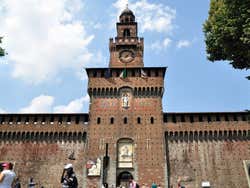
Castello Sforzesco
Castello Sforzesco was built as a fortress during the fourteenth century and is one of the most famous landmarks in Milan. Presently, it houses one of the best museums in the city.
History
Castello Sforzesco was built in 1368. Years later it was enlarged and became a splendid ducal palace, which was then practically destroyed during the Golden Ambrosian Republic.
The Sforza family reconstructed the castle and made it into one of the most magnificent residences in Italy. Years later, the castle was used once more as a fortification under Spanish and Austrian domination.
Napoleon ordered the demolition of the castle in 1800 and a year later the Spanish bastions and towers were destroyed.
During the second half of the 19th century, the population was torn between keeping the Castle or destroying it to build a residential neighborhood. However, the castle remained and the architect Luca Beltrami was instructed to renovate the castle, restoring it as it was when the Sforza family resided in it. The restoration was completed in 1905 and the central tower (Torre Filarete) and the Parco Sempione were inaugurated. The park was built on the former parade grounds.
During World War II, the castle was severely damaged.
At the end of the twentieth century, the Castle's courtyard was built with a fountain in the center. However, in the sixties, it was destroyed when the Milan Metro was built. In 2005, the restoration of the Cortile della Ghirlanda and the halls of the castle were completed.
The Museums
The Castle houses several museums:
- The Museum of Ancient Art: This museum houses the Sforza family’s frescoes and sculptures of great value from various eras like Antiquity, the Middle Ages, and the Renaissance period. The highlights of the museum include the Rondanini Pietà, the last and unfinished work by Michelangelo.
- The Pinacoteca del Castello Sforzesco: This art collection is made up of over 1,500 works of art created between the thirteenth and eighteenth centuries.
- The Museum of Musical Instruments: This museum contains curious instruments from all over the world.
- The Egyptian Museum: The Egyptian Museum houses several objects from Egypt, including statues, mummies, sarcophaguses, and death masks.
- The Archaeological Museum of Milan: This museum contains objects and items from the main cultures that lived in Lombardy from the Neolithic to the Romanization period.
- The Applied Arts Collection: The museum shows the work of pottery makers, sculptors, upholsterers, and weavers.
- The Antique Furniture and Wooden Sculpture Museum: The museum features antiques dating from the fifteenth to the twentieth centuries. The furniture is displayed in various rooms representing several periods.
The Castello also features other exhibitions, such as the Rondanini Museum, the Medal and Numistica Collection, the “Sala delle Asse” by Leonardo da Vinci, the drawing collection, and the engraving collection “Achille Bertarelli”.
A Castle Full of Art
Some of the Sforza Castle’s museum is fascinating. The entrance ticket includes a visit to all the museums. If you do not want to visit the museums, we suggest exploring the castle's central courtyard, which is open to the public and is free to visit.



Schedule
Castle: Every day from 7 am to 7:30 pm
Museum: Tuesday to Sunday, from 7 am to 7:30 pm
Price
Adults: € 10 (US$ 11.78)
Young people aged 18 to 25, and seniors over 65: € 5 (US$ 5.89)
Under 18: free admission.
Free admission on the first and third Tuesdays after 2 pm and the first Sunday of the month
Guided Tour of Castello Sforzesco € 49.90 (US$ 58.81)
Transport
Metro: Cadorna, line M1; Cairoli, line M1; Lanza, line M2
Bus: lines 18, 50, 37, 58, 61 and 94
Tram: lines 1, 2, 4, 12, 14 and 19
Nearby places
Parco Sempione (472 m) Triennale (501 m) San Maurizio al Monastero Maggiore (513 m) Milan Archaeological Museum (519 m) Pinacoteca di Brera (689 m)

